Robert and Christina
Go to Hawaii
Part 3: Friendly Chefs and Museums
Back at our hotel, we washed up,
changed, and went out again, this time to an ABC Stores ourselves, where we
bought a map of Oahu, and then back to the Aloha Sushi from yesterday. The same
woman sold us three handrolls, but this time we splurged on the really expensive,
fancy rolls: our total was $6.84 with tax. Robert handed the woman $22.09 in
cash.
“I don’t know why you
give me that,” she said, but she took the money and entered the amount
into the register. “Oh!” she said. “I know why you give me
that!” She handed us our nice round amounts of change. “How you
do that?” she asked.
“He’s a math person,”
I explained. “He thinks of these things all the time, in his head.”
Of course, the famous Buffy quote about math comes to mind here: "Giles
probably sat there in math class thinking, There should be more math here.
This could be mathier."
“I was a math major,”
Robert said at the same time I did. “I think of numbers all the time—I
like numbers.” The woman told us she was a math person too, an accountant
in college, but that now that she was getting older, she was forgetting the
numbers. Robert agreed that he feels that way as he’s getting older, and
she laughed, before disappearing into the back in order to make our rolls.
I was sorry that we never got to
go back and see her again, but somehow we never had the chance. I’m even
sorrier that there’s no Aloha Sushi around here.
We ate our rolls at a table near
the Starbucks, and then hopped on a TheBus to go over to the Honolulu Maritime
Center, in the harbor. TheBus #19 is apparently the Hawaii equivalent of Boston’s
#1 bus as far as proportion of crazy people go. Crazy man #1 was already on
the bus when we got on, talking loudly to people who didn’t want to answer
him. A smelly crazy man (Crazy man #2) in a trenchcoat got on with us, and sat
down next to Crazy man #1. They seemed to have a nice chat. After a few stops,
a fat crazy man (Crazy man #3) holding a ukulele in a case got on TheBus and
sat on the other side of Crazy man #1. He helpfully put his ukulele as far out
in the aisle as he could in order to block the un-crazy people from entering
or leaving. He joined in the conversation, pausing now and then to drink from
airline-sized alcohol bottles. He didn’t bother putting them in a bag,
but instead sat on the front of TheBus, in the handicapped seats on the right
side, clearly in the driver’s line of sight, and drank openly. He asked
Crazy man #1 if he was Russian, because he liked Russians, but Crazy man #1
denied it. Crazy man #2, the smelly one, leaned across Crazy man #1 to ask Crazy
man #3 (the (obviously) drunk one) to move his ukulele. He did. They got off
one by one so that only Crazy man #3 was left when we got off TheBus. We were
glad, at least, of the free entertainment.

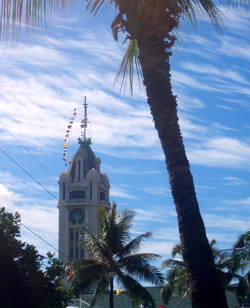 When
we left TheBus, we had a great view of the Aloha Tower, which led to “aloha”
taking on its 20th-century meaning of “hello,” and of a funny new
non-boat boat, which supposedly prevents its passengers from ever being seasick
or feeling the motion of the water. I say “non-boat” because the
literature insists that it’s not a boat—instead, it’s a SWATH,
or a Small Waterplane Area Twin Hull vessel. Here it is, at any rate.
When
we left TheBus, we had a great view of the Aloha Tower, which led to “aloha”
taking on its 20th-century meaning of “hello,” and of a funny new
non-boat boat, which supposedly prevents its passengers from ever being seasick
or feeling the motion of the water. I say “non-boat” because the
literature insists that it’s not a boat—instead, it’s a SWATH,
or a Small Waterplane Area Twin Hull vessel. Here it is, at any rate.
Finally, we started walking up to
the museum, but we were distracted by an old man sitting on a pier and tossing
bread into the water. He was feeding fish, but oh, what fish they were! Bright,
tropical, striped, beautiful fish, such as we’d just seen in the aquarium,
here, at a pier, in the clear water fighting for bread. There was even a crab
or two, scuttling around on the dock. “How do you think they taste?”
asked Robert.
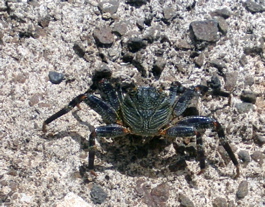
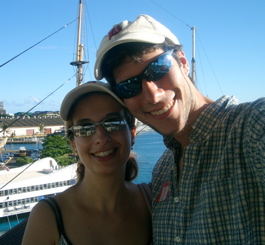
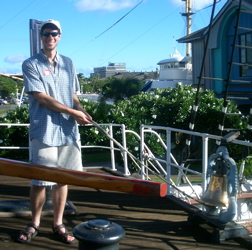 The
Honolulu Maritime Center, and its accompanying ship, The Falls of Clyde, win
our prize hands-down for both the friendliest museum in the world and the most
underrated attraction in Honolulu. The many whaling, shipping, and history exhibits
were good, but the staff went out of their way to help us. There were only two
other people in the entire museum when we were there; you can see the museum
in a couple hours, leisurely, or more quickly if you don’t linger in front
of maps of Captain Cook’s landing sites or things like that.
The
Honolulu Maritime Center, and its accompanying ship, The Falls of Clyde, win
our prize hands-down for both the friendliest museum in the world and the most
underrated attraction in Honolulu. The many whaling, shipping, and history exhibits
were good, but the staff went out of their way to help us. There were only two
other people in the entire museum when we were there; you can see the museum
in a couple hours, leisurely, or more quickly if you don’t linger in front
of maps of Captain Cook’s landing sites or things like that.
Moored next door, The Falls of Clyde
is, as we were repeatedly told, “the only surviving fully-rigged, four-masted
sailing ship left in the world.” It dates to 1878, and it’s a metal-hulled
and oil-powered remnant of the great ocean-freight era of the late 19th and
early 20th century Hawaiian freight runs. A welder doing small repairs on the
boat engaged us in a long conversation when he was about to go home for the
day: he’s from Canada; he didn’t know the Mystic Seaport folks who
came all the way out to Hawaii about 10 years ago to oversee the main part of
the renovation; he came here to study shipbuilding and except for one English
(except he insists it be called “American”) class, he’s done
with his degree; he lives on the north shore, near the Jurassic Park filming,
in a house with ropes around the fence in between the road and the beach; we
should come visit him sometime; we should ring the ship's bell before we left,
so that everyone would know we're here.
On our way off the ship and back
through the museum in order to leave, at 5:00 or thereabouts—closing time—we
met another ship worker, who’s in charge of eliminating leaks. He, too,
chatted with us for a nice long time: he spent most of his day underwater, caulking;
the ship is taking on water at a fast rate, filling up its freight compartments
with water every month or so so they have to be emptied; the ship tilts, getting
ever closer to the building; the best place to view the ship is from the observation
deck upstairs, isn’t it? What? You haven’t been to the observation
deck? Go right up now. We did. They kept the museum open for us. We squinted
and tried to see the tilt, but we couldn’t. When we came back down, the
museum wrote us rainchecks so that we could come back in anytime within a week
to visit them again for free, if we wanted. Wow.
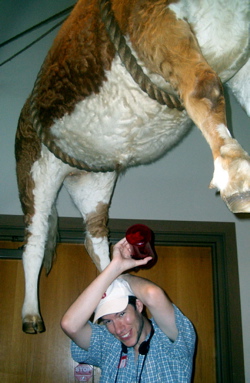

Robert at an exhibit
showing how livestock was taken off the ships and delivered to Hawaii ports.
We waited a long time for a TheBus
to head home, only to discover that the TheBus which had taken us here couldn’t
take us directly back—we’d have to transfer at the Ala Moana Center
instead. So, since it was MacWorld France that day, we took the opportunity
to go into the Apple Store and see banners about the beautiful new all-in-the-monitor
iMacs. We used their internet access, too, and then raced through the mall looking
for what one website had called the best boba drinks in all of Oahu, only to
find out that they’d closed about six months ago. En route, we saw a couple
mall fountains which were pretty standard except that they, too, boasted wonderful
tropical fish. We watched the fish for several minutes as they sniffed around,
but ultimately avoided eating, a penny. After another wait, we caught TheBus
home, with just enough time to wash up, change again (yes, Hawaii is very hot,
and we’d been running around so much we were always getting sweaty), and
go out to dinner.
We took a cab, this time, instead
of a bus, but though this driver used the meter, he was not a very impressive
cabbie. Robert asked him how many cabs there are in Honolulu, what their restrictions
are, and how much a license or medallion costs; we told him about New York statistics,
and while he was interested at first, he gradually started sounding suspicious.
“Why do you want to know all
this?” he asked.
“I like numbers,” Robert
began again, but this guy took it less well than the woman at Aloha Sushi.
The cabbie also got lost, or claimed
to, driving us two or three times further than he needed to and then circling
back, after initially claiming to know just where the restaurant was and even
to have eaten there. We began to doubt this after he asked us why we wanted
to go “all the way” over to our destination restaurant (which, as
we learned from the nice cabbie on the way home, was really all of a three-minute
drive away if you don’t take odd routes), when there were “all these
restaurants right here,” in Waikiki.
We had just passed Todai, the California
all-you-can-eat seafood place, which we do like, in California, and often get
a kick out of, but there was also an Outback Steakhouse, a Tony Roma’s,
and some Italian chain place within sight. “Really?” Robert asked,
sounding worried. “You like the places around here more than where we’re
going?” The cabbie reassured us that yes, he did. “Like what?”
Robert asked, holding his breath. I was more skeptical than Robert, but I held
mine, too—tonight’s dinner had been my idea, with Robert knowing
nothing about what the place was like, and I was nervous.
“Well, like Tony Roma’s,”
the cabbie said, and Robert was suddenly no longer worried.
I’d made reservations a week
or two ago at Alan Wong’s Restaurant downtown, for two at the chef’s
counter—a bar built across the front of the completely open kitchen. The
appetizer station was directly in front of us, with salads to its right and
entrees at the far right. Desserts ran across the back, mostly out of view.
The restaurant was nearly empty, with only one other person at the chef’s
counter, down a few seats, and about half a dozen tables. Our waiter was Jason,
who had moved to Hawaii because he “really wanted to work on [his] surfing.”
Our main chef contact was Doug, the head appetizer guy for the evening, who
talked to us as much as we wanted throughout the evening. There was also Lance,
who was in charge and who Doug kept teasing.
Everyone in the kitchen ran around
each other efficiently, tossing pans of kalua (no, not Kahlua the liqueur—ka’lua,
from the pit, although here they made it in the oven) pig (not pork—you
must always say kalua pig, for some reason, even though they just use the pork
butt here) in and out of the oven, shredding meat, folding foil to roast the
pork and some clams again, using squeeze-bottles galore, and never bumping into
each other. The service was perfect, and Doug gave us tastes of whatever we
wanted—a custard cup full of kalua pig before we ordered, a taste of a
li hing mui (salty plum), prune, and balsamic chutney, which they usually use
in an appetizer, over a scoop of vanilla ice cream when we had an extended conversation
about li hing mui.
I accidentally, but understandably,
confused li hing mui with lilikoi, the yellow passionfruit which is everywhere
here. Robert, who at this point was feeling the effects of jet lag far more
than I, and who at 8:15, even before we ordered, was practically propping his
eyelids open manually, confused poi and poke—not as understandably. When
he realized his confusion, he then attempted to apologize to the waiter, who
had no clue what was going on.
Robert had the five-course chef’s
favorites tasting menu, while I ordered the lobster mousse California roll (no
rice—the lobster mousse substitutes), “da bag” (a savory,
marvelous concoction of kalua pig, spinach, and clams roasted together in foil
and cut open before you), poi (not good. None of our servers or Doug like it
either, they say, although they also say that if you sprinkle it with sugar
it’s a lot better), a steamed opakapaka fish with a shrimp-pork hash (buttery
fish, tasty shrimp layer), and the five brulee tasting dessert (lilikoi, kona
coffee, chocolate, macadamia nut, and litchi). It was a great experience: dinner
and entertainment rolled in one, and even sleepy Robert loved it. Definitely
our best night out in a restaurant, and about the same price as our anniversary
dinner at Bar Masa in New York. We left happily, exhaustedly, and were home
and in bed by 10:30.
back
------------------------ next

 When
we left TheBus, we had a great view of the Aloha Tower, which led to “aloha”
taking on its 20th-century meaning of “hello,” and of a funny new
non-boat boat, which supposedly prevents its passengers from ever being seasick
or feeling the motion of the water. I say “non-boat” because the
literature insists that it’s not a boat—instead, it’s a SWATH,
or a Small Waterplane Area Twin Hull vessel. Here it is, at any rate.
When
we left TheBus, we had a great view of the Aloha Tower, which led to “aloha”
taking on its 20th-century meaning of “hello,” and of a funny new
non-boat boat, which supposedly prevents its passengers from ever being seasick
or feeling the motion of the water. I say “non-boat” because the
literature insists that it’s not a boat—instead, it’s a SWATH,
or a Small Waterplane Area Twin Hull vessel. Here it is, at any rate. 

 The
Honolulu Maritime Center, and its accompanying ship, The Falls of Clyde, win
our prize hands-down for both the friendliest museum in the world and the most
underrated attraction in Honolulu. The many whaling, shipping, and history exhibits
were good, but the staff went out of their way to help us. There were only two
other people in the entire museum when we were there; you can see the museum
in a couple hours, leisurely, or more quickly if you don’t linger in front
of maps of Captain Cook’s landing sites or things like that.
The
Honolulu Maritime Center, and its accompanying ship, The Falls of Clyde, win
our prize hands-down for both the friendliest museum in the world and the most
underrated attraction in Honolulu. The many whaling, shipping, and history exhibits
were good, but the staff went out of their way to help us. There were only two
other people in the entire museum when we were there; you can see the museum
in a couple hours, leisurely, or more quickly if you don’t linger in front
of maps of Captain Cook’s landing sites or things like that. 
